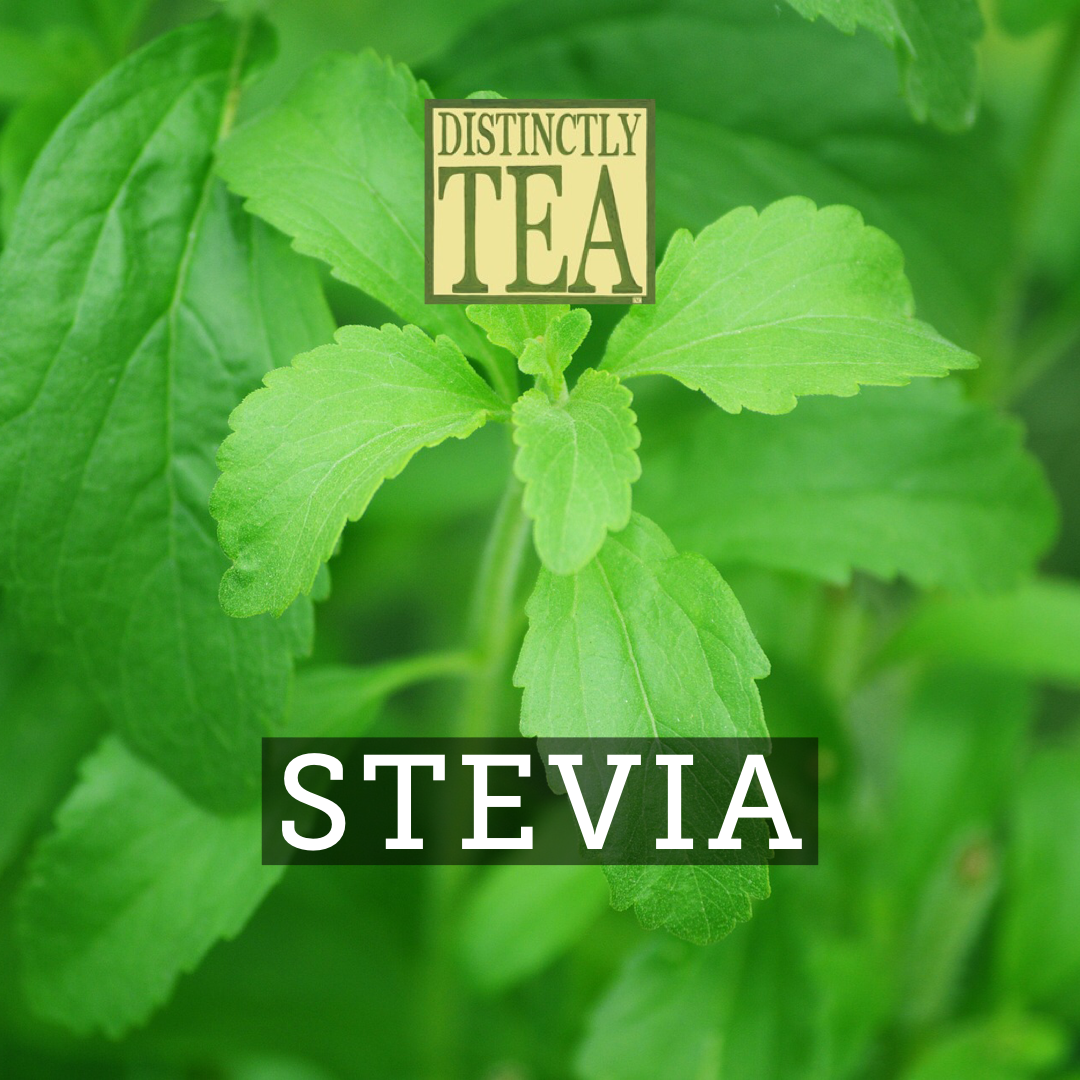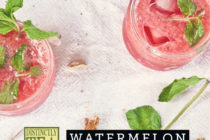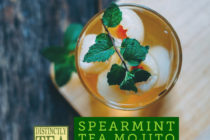Sweetleaf; Sugarleaf; Yerba dulce Stevia rebaudiana
Available in:
-dried leaf
-powdered leaf
-powdered extract standardized 90%
Shop Sweetleaf; Sugarleaf; Yerba dulce Stevia rebaudiana
Stevia
Sweetleaf; Sugarleaf; Yerba dulce
Stevia rebaudiana
Distinctly Tea Inc.
Available in:
-dried leaf
-powdered leaf
-powdered extract standardized 90%
The stevia plant is native to South America, where the people of Paraguay and Brazil have been using it for centuries to sweeten the traditional yerba mate drink and to treat a whole host of ailments. The name stevia actually denotes a rather large genus of plants, although in common language stevia generally refers to the stevia rebaudiana plant. Dr. Moises Bertoni is credited with “discovering” this plant in 1887 and was astounded to find that it is 250-300 times sweeter than sucrose (table sugar). Stevia crossed the radar of science in the early 20th century as a sweeter (and cheaper) alternative to table sugar. Due to health concerns over other artificial sweeteners, the Japanese scientific community, and later the food industry, turned to stevia to sweeten everything from soft drinks, to candy, pastry and began using it as a table sweetener. It has been used extensively in Japan and other parts of the world since the 1970’s with no reported side effects or health concerns with much research to support its safety. North America, however, was much slower to adopt stevia because there was already a very competitive industry for artificial sweeteners, and as a natural substance, stevia was difficult to patent. When the glycosides (the active chemically “sweet” components of the plant) stevioside and rebaudioside were isolated, the North American Food and Drug Industry began to look much closer at this healthier alternative and research began. Even today, there is much debate whether stevia should be marketed as a “dietary supplement” or a “food additive” – an important difference if it is to be further adopted into mainstream products.
Stevia has garnered attention in later years because it is a cost-effective sweetener that does not raise blood pressure or blood-glucose levels — interesting implications for a society burdened by such chronic diseases as hypertension and diabetes. This natural sweetener is considered non-caloric because when it is metabolized in the GI tract, the steviosides and rebaudiosides are converted to steviol, which is only minimally absorbed while the majority is eliminated in the feces. Although clinical research is somewhat conflicting, it appears that steviosides may act directly on the insulin-secreting beta cells of the pancreas. At the same time, insulin sensitivity may be improved (as well as more being secreted) and more glucose mobilized to be available for use by skeletal muscles. Thus, there is potential for stevia to encourage the body to process and handle glucose more effectively, without adding an increased burden of glucose. To that effect, an extract of stevia leaf actually increased glucose tolerance and reduced plasma glucose levels in a small study involving healthy volunteers with normal blood glucose levels — although whether these same effects apply to diabetics is yet to be conclusively confirmed. Studies are conflicting in terms of lowering blood pressure as well: some human and animal studies note that blood pressure can be reduced while others involving hypertensive patients failed to find a statistically significant difference. The basis for its effectiveness (sometimes) may be that in some animal studies, it was found that stevia can act as a vasodilator and diuretic — thus when the blood vessels are dilated and excess fluid is excreted, hypertension becomes less pronounced. In contrast, it is interesting to note that other studies, again, notice the most significant reduction in hypertension and blood-glucose levels while taking stevia when these parameters are elevated beyond the normal — more so than when they are within the normal range. Thus, it is difficult to say conclusively that stevia does or does not always reduce elevated levels (of blood-glucose or blood-pressure, for example) and if so, by how much and for whom — but more often than not there is some change. Stevia may also be a mild anti-bacterial: in vitro studies, stevia actually acted as a bactericide to many food-borne pathogens studied (including E.coli). In the GI tract it also has the potential to ward off human colon carcinoma cells. Although some early studies from the 1980’s showed some constituents of stevia to be potentially mutagenic, it was later found that the methodology used in these trials to be faulty and not reproducible. Centuries of use, and world-wide commercial use today speak more to the safety of this natural substance than one flawed clinical study. At any rate, stevia is a natural calorie-free alternative to the blood-sugar spiking, cholesterol-elevating high-fructose corn syrup, and carcinogenic artificial sweeteners.
Dried stevia leaves can be ground and used as a sweetener, or soaked in water and the liquid used in baking or in preserves. A pinch of the leaf is enough to sweeten tea, or a little more may be added to many dishes or sprinkled onto food. The powdered extract is very concentrated so only a small amount is needed. For example, the amount that fits onto the tip of a toothpick is often said to be enough to sweeten tea or coffee. If you plan to use stevia in baking, a general guideline is that 1/4 tsp. of the powdered extract or 2 tbsp. of the dried leaf is equivalent to 1 cup of granulated sugar. Stevia is also heat-stable (unlike other artificial sweeteners) so it can be incorporated safely — but remember to
adjust ingredient ratios for the sweetness!
STEVIOSIDE HAS BEEN USED SAFELY FOR UP TO 2 YEARS AT A DOSAGE OF 1500 MG/DAY IN CLINICAL TRI-
ALS. SIDE EFFECTS, ALTHOUGH UNCOMMON, MAY INCLUDE GI UPSET, HEADACHES, DIZZINESS, AND
MYALGIA ALTHOUGH CLINICAL TRIALS HAVE NOT REPORTED THESE EFFECTS TO BE SIGNIFICANT OR IN
ANY WAY PREVALENT. PEOPLE WITH ALLERGIES TO THE ASTERACEAE FAMILY (DAISIES, MARIGOLDS,
CHRYSANTHEMUMS, RAGWEED ETC.) MAY REACT TO STEVIA. EXERCISE CAUTION WHEN COMBINING STE-
VIA WITH ANTI-HYPERTENSIVE HERBS OR MEDICATIONS AS THESE MAY THEORETICALLY HAVE A COM-
POUNDING EFFECT AND LOWER BLOOD PRESSURE BELOW A NORMAL LEVEL. LAB VALUES MAY ALSO BE
ALTERED. HUMAN AND ANIMAL STUDIES INDICATE THAT STEVIA HAS A NEGLIGIBLE EFFECT IN CASES OF
MILD HYPERTENSION AND LOW-NORMAL BLOOD-PRESSURE ALTHOUGH RESULTS ARE MIXED IN OTHER
CASES OF HYPERTENSION. HERBS TO WATCH INCLUDE CAT’S CLAW, COENZYME Q-10, GARLIC, NETTLE,
AND FISH OIL, WHILE MEDICATIONS INCLUDE CAPTOPRIL, ENALAPRIL, LOSARTAN, VALSARTAM, AM-
LODIPINE, HYDROCHLOROTHIAZIDE, FUROSEMIDE ETC. CONTSTITUENTS OF STEVIA MAY ALSO THEO-
RETICALLY INTERACT WITH ANTIDIABETES DRUGS TO CREATE A HYPOGLYCEMIC EFFECT IN THE BODY.
BE CAUTIOUS WHEN COMBINGING WITH BLOOD-SUGAR LOWERING HERBS LIKE ALPHA-LIPOIC ACID, BIT-
TER MELON, CHROMIUM, DEVIL’S CLAW, FENUGREEK, FARLIC, GUAR GUM, HORSE CHETNUT SEEND,
PANAX GINSENG, SIBERIAN GINSEG , PSYLLIUM ETC AND ANTI-DIABETES MEDICATIONS. MOST STUDIES
HAVE SHOWN THESE EFFECTS TO BE LOW-RISK, ALTHOUGH SETVIA MAY ALTER LAB VALUES FOR BLOOD
SUGAR. SINCE ANIMAL STUDIES SHOW THAT STEVIA MAY ACT AS A DIURETIC, THUS PATIENTS TAKING
LITHIUM MAY NEED TO ADJUST DOSAGES. PLEASE MAKE SURE TO USE AN ADDITIONAL FORM OF CONTRA-
CEPTION AS STEVIA IS NOT A RELIABLE FORM OF BIRTH CONTROL.
For educational purposes only. This information has not been evaluated by the Canadian Food & Drug Administration.
This information is not intended to diagnose, treat, cure or prevent any disease.
www.distinctlytea.com 866-326-2221 distinctlytea@rogers.com
Research compiled and summarized by Keila McCullough, BHSc, ND (cand.)
Sources:
“A critical review of the genetic toxicity of steviol and steviol glycosides”. Brusick DJ. Food Chem Toxicol. 2008 Jul;46 Suppl 7:S83-
91. [abstract].
“A double-blind placebo-controlled study of the effectiveness and tolerability of oral stevioside in human hypertension”. Chan P,
Tomlinson B, Chen YJ, et al. Br J Clin Pharmacol 2000;50:215-20.
“Apparent lack of pharmacological effect of steviol glycosides used as sweeteners in humans. A pilot study of repeated exposures in
some normotensive and hypotensive individuals and in Type 1 and Type 2 diabetics”. Barriocanal LA, Palacios M, Benitez G, et al.
Regul Toxicol Pharmacol 2008;51:37-41.
“Effects of stevioside on glucose transport activity in insulin-sensitive and insulin-resistant rat skeletal muscle”. Lailerd N, Saengsirisu-
wan V, Sloniger JA, et al. Metabolism 2004;53:101-7.
“Efficacy and tolerability of oral stevioside in patients with mild essential hypertension: a two-year, randomized, placebo-controlled
study”. Hsieh MH, Chan P, Sue YM, et al. Clin Ther 2003;25:2797-808.
“Investigation of the antihypertensive effect of oral crude stevioside in patients with mild essential hypertension”. Ferri LA, Alves-Do-
Prado W, Yamada SS, et al. Phytother Res 2006;20:732-6.
“Specific immunomodulatory and secretory activities of stevioside and steviol in intestinal cells”. Boonkaewwan C, Ao M, Toskulkao
C, Rao MC. J Agric Food Chem 2008;56:3777-84.
“Stevia History”. Stevia Café.net. http://www.steviacafe.net/stevia-history
“Stevia” Monograph. Natural Medicines Comprehensive Database. http://www.naturaldatabase.com/
“Stevioside”. Geuns JM. Phytochemistry 2003;64:913-21.
“Stevioside acts directly on pancreatic beta cells to secrete insulin: actions independent of cyclic adenosine monophosphate and
adenosine triphosphate-sensitive K+-channel activity”. Jeppesen PB, Gregersen S, Poulsen CR, Hermansen K. Metabolism
2000;49:208-14.
“Stevioside and related compounds: therapeutic benefits beyond sweetness”. Chatsudthipong V, Muanprasat C. Pharmacol Ther.
2009 Jan;121(1):41-54. [abstract].
Photo Courtesy Of:
Research compiled and summarized by Keila McCullough BHSc, ND (cand.)
SIDE EFFECTS ARE RARE UNLESS SIBERIAN GINSENG IS TAKEN IN VERY HIGH AMOUNTS. THESE MAY INCLUDE SLIGHT DROWSINESS, ANXIETY, IRRITABILITY, MELANCHOLY, DIARRHEA, MASTALGIA AND UTERINE BLEEDING. LONG TERM USE MAY BE ASSOCIATED WITH AGGRAVATED SCIATIC NERVE PAIN. SIBERIAN GINSENG MAY HAVE HYPOGLYCEMIC EFFECTS THUS DIABETICS SHOULD BE CAUTIOUS WHEN TAKING THIS AS A SUPPLEMENT. CONCOMMITENT USE OF THIS HEREWITH OTHER HERBS OR MEDICATIONS ALTERING PLATELET AGGREGATION COULD THEORETICALLY INCREASE THE RISK OF BLEEDING. SOME CYTOCHROME P450 MEDICATIONS MAY ALSO BE ALTERED BY THE USE OF THIS HERB, INCLUDING 1A2 AND 2C9 SUSBSTRATES SUCH AS CLOZAPINE, IMIPRAMINE, PENTAZOCINE, PROPANOLOL, AMITRIPTYLINE, WARFARIN, VERAPAMIL AND DIAZEPAM. ALCOHOL AND CENTRAL NERVOUS SYSTEM DEPRESSANTS MAY THEORETICALLY INCREASE THE SEDATIVE EFFECTS OF SIBERIAN GINSENG. PATIENTS TAKING LITHIUM MAY NEED TO READJUST MEDICATION DOSAGES DUE TO THE POTENTIAL DIURETIC EFFECTS OF SIBERIAN GINSENG AND THE POTENTIAL TO RAISE BLOOD LEVELS OF LITHIUM.
For educational purposes only. This information has not been evaluated by the Canadian Food & Drug Administration.
This information is not intended to diagnose, treat, cure or prevent any disease. www.distinctlytea.com 519-578-2010 distinctlytea@rogers.com
Research compiled and summarized by Keila McCullough BHSc, ND (cand.) Distinctly Tea Inc.
Sources:
“Assessment of the effects of eleutherococcus senticosus on endurance performance”. Goulet ED, Dionne IJ. Int J Sport Nutr Exerc Metab. 2005 Feb;15(1):75-83.
“Cardioprotective and antiarrhythmic properties of preparations from Leuzea carthamoides, Aralia mandshurica, and Eleutherococcus senticosus”. Maslov LN, Guzarova NV. Eksp Klin Farmakol. 2007 Nov-Dec;70(6):48-54.
“Chinese Drugs of Plant Origin”. TangW, Eisenbrand G. Heidelberg, Germany: Springer Verlag; 1992:1.
“Constituents and pharmacological effects of Eucommia and Siberian ginseng”. Deyama T, Nishibe S, Nakazawa Y. Acta Pharmacol Sin. 2001 Dec;22(12):1057-70.
“Effects of various Eleutherococcus senticosus cortex on swimming time, natural killer activity and corticosterone level in forced swimming stressed mice”. Kimura Y, Sumiyoshi M. J Ethnopharmacol. 2004 Dec;95(2-3):447-53.
“Eleutherococcus senticosus. Monograph”. No author. Altern Med Rev. 2006 Jun;11(2):151-5.
“Eleutherococcus senticosus (Rupr. & Maxim.) Maxim. (Araliaceae) as an adaptogen: a closer look”. Davydov M, Krikorian AD. J Ethnopharmacol 2000;72:345-393.
“Extract from Acanthopanax senticosus harms (Siberian ginseng) activates NTS and SON/PVN in the rat brain”. Soya H, Deocaris CC, Yamaguchi K, Ohiwa N, Saito T, Nishijima T, Kato M, Tateoka M, Matsui T, Okamoto M, Fujikawa T. Biosci Biotechnol Biochem. 2008 Sep;72(9):2476-80. Epub 2008 Sep 7.
“Ginseng, Siberian” Monograph. Natural Medicines Comprehensive Database. http://www.naturaldatabase.com
“Siberian Ginseng”. University of Maryland Medical Centre. http://www.umm.ed altmed/articles/siberian-ginseng- 000250.htm
“Release of acetylcholine by syringin, an active principle of Eleutherococcus senticosus, to raise insulin secretion inWistar rats”. Liu KY,Wu YC, Liu IM, YuWC, Cheng JT. Neurosci Lett. 2008 Mar 28;434(2):195-9. Epub 2008 Jan 31.
Research compiled and summarized by Keila McCullough BHSc, ND (cand.)




0 Comments